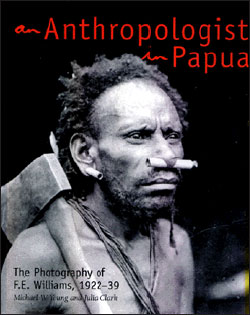An Anthropologist in Papua The Photography of F.E. Williams, 1922-1939
This book is a pictorial celebration of the work of a brilliant ethnographer.
F.E. Williams was one of the most talented and productive anthropologists of his generation.
Australian-born and Oxford-trained, he spent twenty years - the entirety of his working career -
as Government Anthropologist in the Australian Territory of Papua, then ruled by the ‘benignly
paternalistic’ proconsul Sir Hubert Murray.
One of the aims of An Anthropologist in Papua is to document, through Williams’s photographs
and, wherever possible, through his words, the sheer variety of his ethnographic discoveries
and fieldwork experiences. Some 235 images have been selected, about 200 of which appear
in print for the first time.
A substantial introductory essay provides the biographical, historical and anthropological contexts
of Williams’s ethnographic and photographic achievement. Such contexts are essential for a proper
appreciation of his work: notably, the colonial milieu of Papua in the 1920s and 1930s; Williams’s
important relationship with Lieutenant Governor Murray (with whom he did not always see eye to
eye); and his relationship with academic mentors such as Malinowski and R.R. Marett (who memorably
said of Williams that he was ‘a fine soldier who would make a grand explorer’).
Williams commitment to applied anthropology partly eclipsed his scholarly achievements. His
career was coterminous with the reign of functionalism in British social anthropology. This is a
good part of his historical significance, because he was in a unique position to fulfil some of the
prescriptions of Bronislaw Malinowski’s revolution concerning intensive (and extended) fieldwork
and ‘practical’ anthropology. It was fitting, too, that Williams worked in Papua, homeland of the
British ethnographic tradition as developed by A.C. Haddon and C.G. Seligman, and brought to
full maturity by Malinowski. As the dominant theoretical paradigm between the wars, functionalism
was impossible to ignore. Although a diffident theorist, Williams was a discerning and exacting
one. While accepting functionalism in good measure, he had the practical experience to judge its
limitations. He repudiated the view that cultures were integrated wholes and that societies were
systems of smoothly interlocking institutions. His argument that culture was always to some extent
‘a hotch-potch and sorry tangle’ was heresy in the halls of British academe, and it is arguable that
Williams’s peers denied him the reputation he deserved.
Williams’s fieldwork in Papua was of unprecedented breadth and duration. The rich and varied
ethnography he bequeathed (most of it published in six monographs) is complemented by some
2000 glass plates and negatives. His photographic records of the peoples among whom he worked
spans almost twenty years: from 1922, when he made his first trip to the Purari Delta, to 1939, when
he visited the newly contacted Lake Kutubu and neighbouring valleys. During this period, Williams
took photographs in about eighteen different ethnographic locations scattered throughout the eight
administrative divisions of the territory. His photography is therefore unique in its coverage of the
inhabitants of Australia’s largest colony.
|
|

AUTHOR:
Michael Young & Julia Clark
STATUS:
Back List
PRICE:
$59.95
ILLUSTRATIONS:
235 photographs, 9 maps
FORMAT:
Portrait; hardcover; 320 pages
DIMENSIONS:
285 x 240 mm
ISBN:
1863332006
|
|

